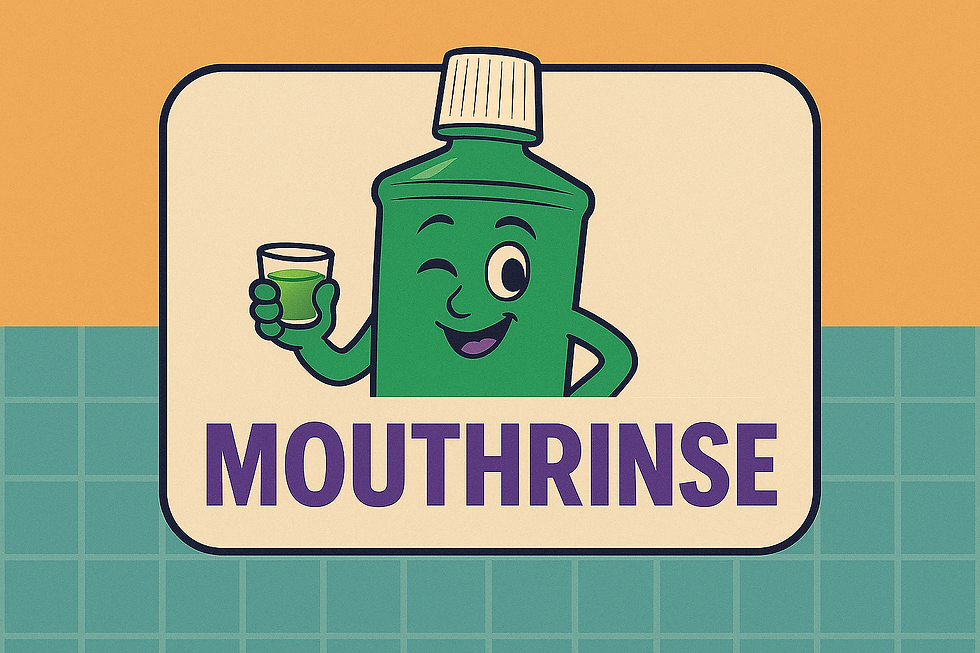Floss
- naytoghlo
- Apr 21, 2025
- 3 min read
Updated: Apr 23, 2025

Alright, let's talk about the "F-word"... Flossing! Meet Flossie, the unsung hero who bravely goes where no toothbrush bristle can effectively venture. Your brush does a great job on the open surfaces, but what about those cozy spots between your teeth? That's where plaque loves to party and leftover food ninjas hide out – we're talking about nearly 40% of your tooth surfaces that brushing misses! Flossie's mission is to slide in there and give those freeloaders the boot.
Now, full disclosure: even dentists (yes, even me!) sometimes find mustering the energy to floss a challenge. I confessed my own struggles with the "floss laziness" right here: My Floss Confession: Even Your Dentist Struggles Sometimes!. So, if you find it tricky, you're in good company! But knowing why it's crucial and exploring the options can make all the difference.
Decoding the Floss Universe: Finding Your Perfect String

The floss aisle can be dizzying! Let's break down the main players:
Standard Nylon Floss: The classic. Comes in multifilament strands.
Waxed: Slides a bit more easily, less likely to shred, especially between tight contacts.
Unwaxed: Thinner, might feel like it squeaks more when teeth are clean. Can sometimes fray more easily.
Flavored: Minty freshness is the most common, but you can find cinnamon, bubblegum... you name it! Adds a little fun.
PTFE Floss (Monofilament): Made from the same material as Gore-Tex. It's a single filament, so it glides verysmoothly between teeth and is virtually shred-proof. Great for tight contacts. (Think brands like Glide).
Floss Tape: Wider and flatter than standard floss. Some people find the broader surface area feels more effective or gentler on the gums.
Textured / Woven Floss: These flosses often have more texture, sometimes described as spongy or fibrous. They can be excellent at grabbing plaque. A popular example is Cocofloss, known for its unique, almost loofah-like texture and fun scents – it feels different and many people love how effectively it cleans.

Superfloss / Floss Threaders: These are special tools designed for cleaning around braces, bridges, and implants. Superfloss often has a stiff end to thread, a spongy section for cleaning around appliances, and regular floss for other areas. Floss threaders are separate loops to help guide regular floss under bridgework or wires.
Using floss correctly makes it way more effective (and less likely to hurt!):

Get Enough: Break off a generous amount – about 18 inches (roughly elbow to fingertip). Yes, really! You need enough for clean sections.
Wind It Up: Wrap most of it loosely around one middle finger, and a small amount around the other middle finger. This second finger will take up the used floss.
Get a Grip: Use your thumbs and index fingers to guide about an inch of floss between your teeth. Keep it taut.
Gentle Glide: Use a gentle back-and-forth sawing motion to ease the floss between the teeth. Don't snap it down onto your gums! Ouch!
The C-Shape Hug: Once between the teeth, curve the floss into a "C" shape against the side of one tooth. Gently slide it just below the gumline until you feel slight resistance.
Scrape Up (or Down): Gently scrape the floss up (for lower teeth) or down (for upper teeth) along the side of the tooth, moving away from the gumline.
Repeat: Re-curve the floss into a C-shape against the other tooth in that same gap and repeat the scrape.
Fresh Section: Wind the used section onto the one middle finger and release a fresh section from the other finger.
Move On: Go to the next gap and repeat until you've cleaned both sides of every tooth, including the back surface of your very last molars!
Finding Your Rhythm (Like I Talked About in My Blog!)
The absolute best floss is the one you'll actually use consistently! Don't love string floss? As I mentioned in my confession blog, floss picks, water flossers (like Waterpik™), or interdental brushes are fantastic alternatives or additions. Explore what works for you. Maybe it's fun-flavored Cocofloss that motivates you, or the convenience of picks by the sofa.
The key is consistency. Make Flossie your friend, find your groove, and give those hidden surfaces the cleaning they need for a truly healthy smile!
For more detailed steps and official guidelines on flossing and brushing technique, check out the Canadian Dental Association's page: https://www.cda-adc.ca/en/oral_health/cfyt/dental_care/flossing_brushing.asp



Comments